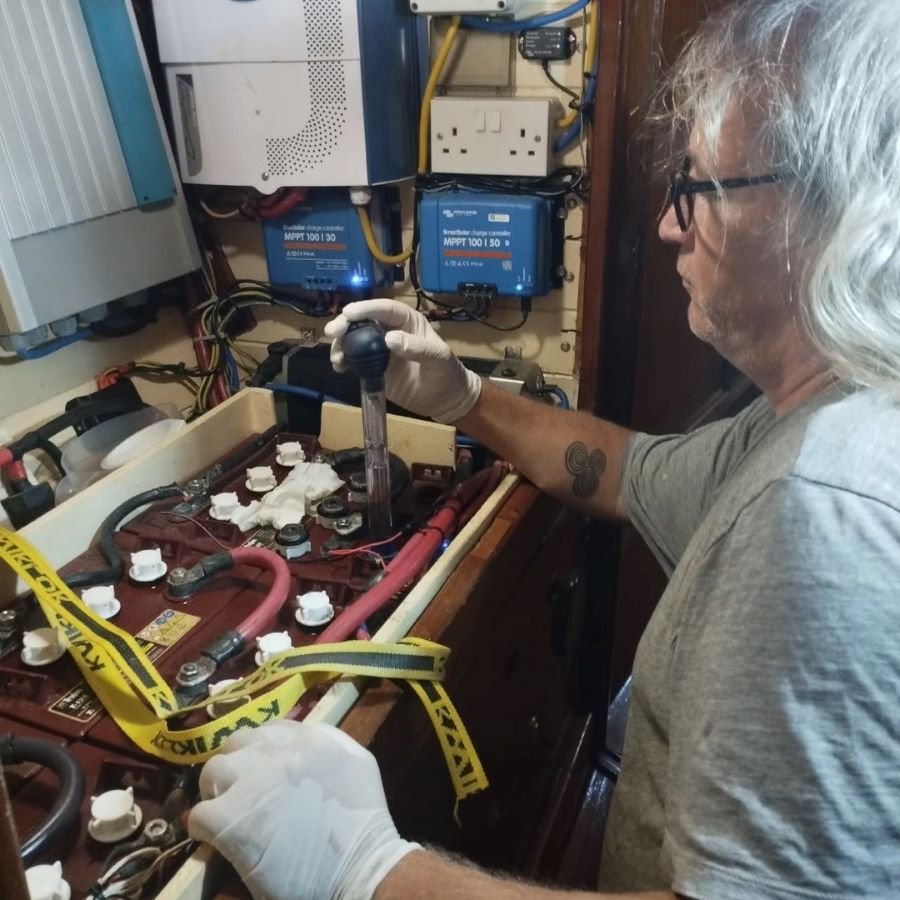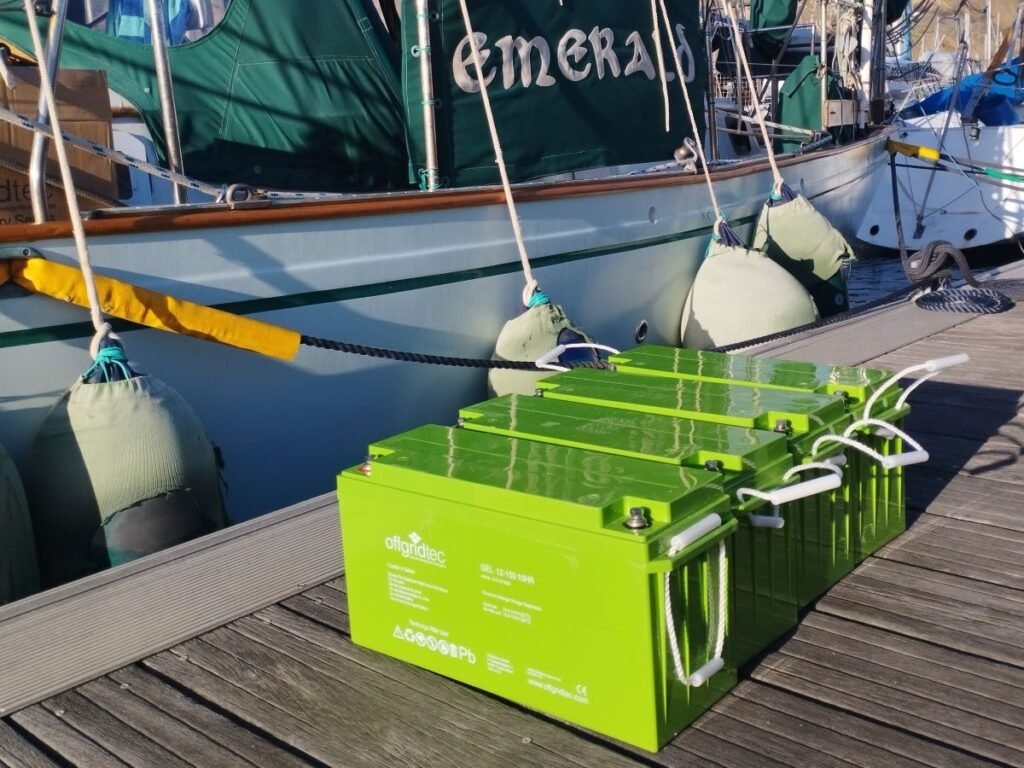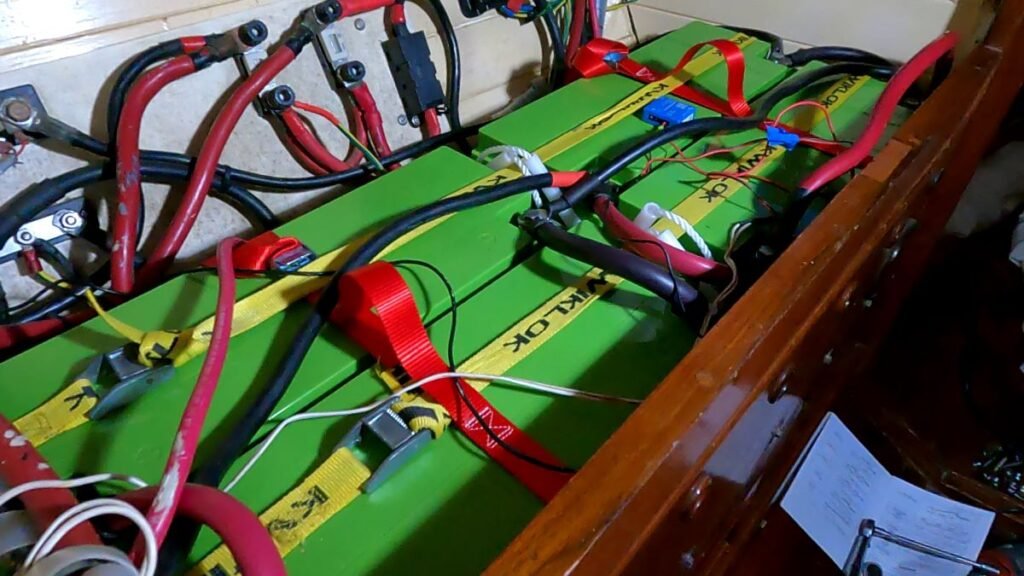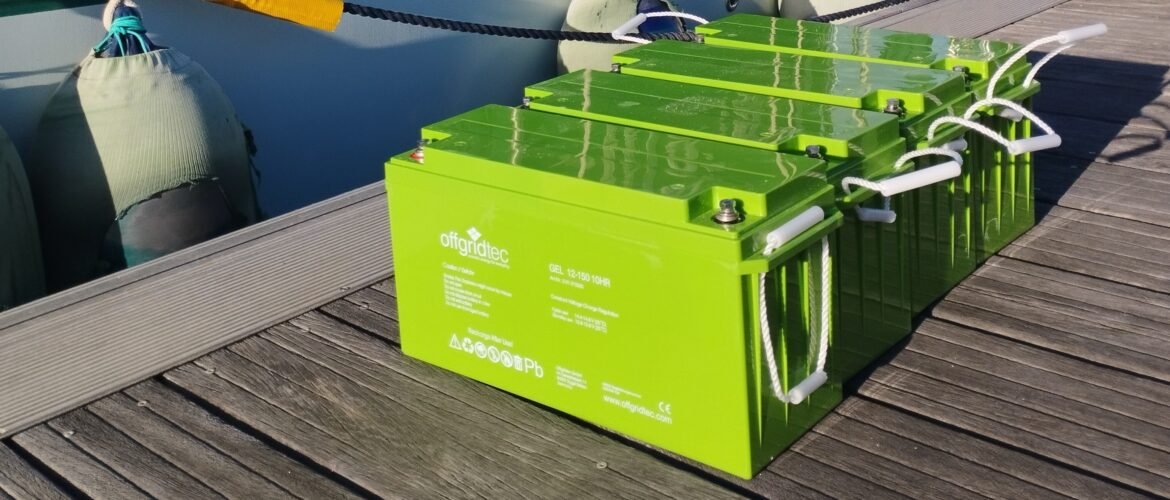Back in October we were basking in the glory of Emerald’s successful launch from the boatyard, but unknown to us, there was a problem brewing with our sailboat batteries.
It had been a wonderful feeling to be back swaying gently to Emerald’s movement on the water. The engine had performed perfectly and there were no leaks from the many potential sources of leakage. We felt very proud of what we’d achieved. On our first evening back afloat, the sunset put on a beautiful show to backdrop our celebrations.

Sailing Requires Many Skills, Including Being an Acrobat
However, we still had a couple of jobs to complete to make Emerald fully ship shape again. The day after launch was sunny and windless, the perfect opportunity to refit the AirX wind generator. We’d had to remove it to fit Emerald into the crane, but now, with fewer sunlight days and a damaged solar panel, we were going to need all the electrons that we could generate.
The AirX wind generator sits on top of a pole on Emerald’s aft starboard side. Refitting it involved Colin performing some daring, acrobatic feats. We rigged complicated rope harnesses to hold ladders and him in place and allow him to climb above the solar arch. Next, we used the boom’s topping lift to help hoist the heavy generator head onto the top of the solar panels.
Colin then hung off of the side of the solar arch to fit the generator onto the pole. He held it in place while I had the nerve wracking job of fitting the 6 bolts into their slots without dropping them. With the bolt in place, I then had to place the fiddly washer and nut onto the bottom of each of them. We were performing these feats on a gently swaying platform, plus I was at the end of my reach. If I dropped any, we’d need to dive to try and retrieve them. So, it was a tricky job.
Power From Mother Nature Wasn’t Enough
The wind returned over the next few days and our ears became reacquainted with the hum of the AirX. Between it and the sun, we were able to keep up with our power needs.
But it wasn’t to last. Cloudy, still days returned and we found that we were having to use the engine to top up the batteries. Overnight is when the batteries take their biggest hit, with nothing going in but with the boat systems still taking out. Whilst I was away for a couple of weeks, Colin noticed that the voltage of the batteries had become very low by morning. The fridge and freezer are the biggest draw and he started to turn them off overnight. But still the battery voltage plummeted. He reached the conclusion that at least one of our 6 batteries had failed.
Emerald’s Battery Bank is Failing
We’d last replaced the power bank in early 2017 using 6 x 6V Trojan T125 lead acid deep cycle/traction batteries. They led a very pampered life with monthly checks and top ups with water. We also rotated them once a year to evenly distribute the loads on the lead cells. We’d spent the last 16 months plugged in to a plentiful power supply, so they hadn’t really had had much to do. We expected to get at least another year of use from them and had a plan for a Lithium LiFePO4 upgrade.
However, as with most plans, the batteries had different ideas to ours. Just two weeks after launching we had to face the reality that we had at least one failure.
Testing the Batteries
We have a hydrometer as part of Emerald’s extensive tool collection, and with this we could test the specific gravity of the acid in each battery. Colin took a sample from each cell and compared it to the figures on the battery data sheet. The result was that one battery had a completely dead cell and another an almost dead cell. When he checked the voltage across the terminals, the figures backed this up. The two sick batteries had a significantly lower voltage than they should.
Colin reconfigured our bank of 6 into a bank of 4. As luck would have it, a space on a harbour pontoon was available. We quickly took the opportunity to move there as plugging into shore power would give us time to assess our options without having to run the engine for charging. Nor would we have to worry about turning off our freezer which we’d recently stocked in anticipation of sailing away to new adventures.

Decisions, Decisions: Lithium or Lead Acid?
A Lithium LiFePO4 (from now on shortened to Lithium) battery upgrade was on our list of future upgrades for Emerald. However, with everything else that has happened over the last year or so, it was very much on the back burner. We’d expected the current batteries to give us another year of use, during which time we’d design and plan the Lithium upgrade.
But now, our hand was being forced and we had a decision to make: to bring the Lithium upgrade forward or to stick with lead acid.
The Benefits of Switching to Lithium
Lithium LiFePO4 batteries are a modern technology with many benefits over the older, lead acid type batteries.
Lithium has faster, more efficient charging from renewable sources. With lead acid, the fuller they get, the less of the available charge they take. For example, with batteries at 80% full and generating 50A of solar, the lead acid would only take 20% of that. Whereas the Lithium will just keep taking it all.
The power output of the Lithium batteries is much more stable with heavy loads, such as inverters. This would allow us to switch to electric cooking in our galley, rather than using non-renewable propane gas.
A longer life. The Lithium batteries can tolerate many more charge-discharge cycles. On average, the type of lead acid batteries that we’ve used have a 5 year lifecycle. With Lithium we could expect at least 5 times that.
It is possible to discharge Lithium batteries almost to zero without damage. To do this to a lead acid battery would significantly shorten its life. This would be a benefit when temporary bad weather situations reduce our solar output. With lead acid we’d have to use alterative sources (main engine, petrol generator) to top them up. With the Lithium, we’d just have to wait a couple of days for better weather to return. And all that without any damage to the Lithium.
Our existing lead acid batteries provide a usable 330Ah with a weight of 180kg. With a change to Lithium with the same physical size we would have 720Ah for only 80kg of weight.
The Negatives: Availability of Products
A Lithium upgrade sounds like a no brainer. However, there were a couple of location and financial factors to throw into the mix.
As well as the batteries, we’d need to upgrade the battery wiring. We’d also need to modify the engine charging system, which would require a new kind of alternator charger to what we currently have.
None of the Lithium batteries, wiring materials or the new alternator were available locally on this small island. They could all be delivered, but with an unknown time impact. During the time that we’ve been on Porto Santo, our deliveries have taken between 3 and 6 weeks. Others have also had issues with deliveries taking much longer than specified as well as things going missing.
Cost
Delivery to the island would have an additional cost impact and the Lithium upgrade itself would total around 4 times more than replacement with lead acid. Yes we’d reap the rewards of that in the future, but with other unexpected drains on our finances, and more urgent boat upgrades in the pipeline, the timing was not good right now.
Our Decision
Cost was the major factor, followed by the waiting time for deliveries. Plus, we’ve really had enough of big boat jobs for a while. We’ve spent most of the last 2.5 years in a boatyard, working on some major boat improvements and repairs, with the engine rebuild being particularly challenging. We really, really need to get back to the cruising life to remind ourselves why we do it. So, taking all these issues into account, we decided to stick with lead acid for the time being.
We found a supplier in the Canary Islands that had suitable batteries in stock. The plan was to sail straight there, while nursing our reduced battery bank. Once there, we’d change the batteries and then be free to explore.
But the boat had other ideas. Issues with an over heating propeller shaft rudely curtailed our sail south and we limped back to Porto Santo.
What Next?
We still needed batteries. Emerald needed to go back to the boatyard to investigate the prop shaft issue with a provisional date for a space in early January. There was space to wait on the pontoon with shore power until the yard space became available, but the longer that we pushed the reduced battery bank for, the higher the risk of more of them failing.
We did now had some time on our hands, but with the overheating prop still to investigate and hopefully repair, we were loath to add yet another boat job on top. Hopefully a couple of weeks in the yard would see us good and we’d still have time to sail south.
So, we were looking to replace with another bank of wet lead acid batteries. We had limited choices whilst on the island as many companies won’t deliver to Porto Santo. We were able to find lead acid car batteries locally, but they’re not the best for our intended use. The lead plates within them are thinner than traction/deep cycle batteries so they don’t last as long but are a similar price.
We’re Changing to Gel Lead Acid
Having found nothing we liked locally, we next contacted a number of European companies that supply lead acid deep cycle batteries. But none of them wanted to deliver the wet lead acid type overseas. So, the next option was to use gel lead acid. Traditionally, the gel type has been more expensive than wet, but prices are now much more comparative. There are other advantages in that they need much less maintenance and they’re sealed, so there’s no risk of acid spilling out.
A German company replied that they had what we wanted in stock and that they could ship to Porto Santo. Their estimate was ten days, but with Christmas coming and our knowledge of the postal system here, we expected nearer three weeks.

Installing the New Gel Lead Acid Batteries
The new batteries arrived on the 2nd January, which was just under 3 weeks from ordering. So, our estimate was pretty good!
The new bank has four batteries to replace the previous six. This meant a small amount of reconfiguring was needed in the space where they are stored. The old battery storage box had to come out, but this was a good thing as it had been damaged by acid spillage over the years. Colin also made two new cables, but we had the spares onboard to be able to do that.
Within a day the new batteries were securely installed, wired up and providing power for us.
A Lithium LiFePO4 upgrade is still in our future, but we now have some breathing space in which to plan the work and source all the parts. And hopefully there’ll be some sailing fun too!


The Social Media Bit: Want to Follow Us?
If you’d like to follow us on other social media platforms (Facebook, Instagram and YouTube), you can do so by using these links:
Or use the link below to track our voyage on NoForeignLand.com.
And finally, you can sign up to receive email notifications of new blogs using the subscribe box at the bottom of this page.
Thank you from Nichola & Colin




I think you made a good choice!
Thanks Ann
Gel batts, ok, make sure to charge them correct. or they will be going bad very fast. i did have the same leads. as you had, worked fine, but i did change for LiPo4 Winston, and it is super. solar powers. my bank, did not any thing to altenators, not over heating. runds fine.
Thank you for the useful information, we’ll keep an eye on the gel batteries. We hope to be able to upgrade to LiFePO4 in the next couple of years
Well Em certainly likes Porto Santo !!! – either that or she is not keen on your sailing plans…:-) is there anything left for you to change or upgrade on her ?? I have no knowledge about sail boats, but just about everything else is going to Lithium including the automotive world.
Hi Phil, much of our safety equipment is reaching its end of life or due for a service, so that’s the most urgent upgrade. Then there’s Colin’s solar upgrade – most of our panels were bought over 15 years ago. With improvements in technology we can get much more efficient ones with higher output for the panel size. Plus prices are crazy low at the moment.